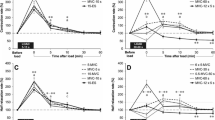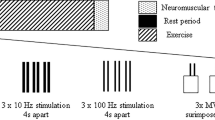Abstract
The minimal rectangular current pulse that produces a single contraction of reference muscles at different pulse durations has been recommended as a marker of the neuromuscular excitability (NME) of skeletal muscles. NME is improved in well-trained, non-fatigued endurance athletes and deteriorates after prolonged heavy exercise and high-volume overtraining. The hypothesis was tested that a deterioration in NME also indicates an early stage in the overtraining process during high-intensity endurance training. Six subjects participated for 40–60 min per day in a 6-week, 6-days-per-week, intensive, steady-state and interval training program using a cycle ergometer. Training was stopped each day on volitional exhaustion. On day 7 of each week training was of low intensity for about 30–40 min. Submaximum and maximum power output were significantly increased after 3 weeks, but there was no further improvement, rather a deterioration after week 6 compared to week 3. Even after 2 weeks of regeneration no supercompensation was evident, rather a decrease in maximum power output. NME was slightly improved after 3 weeks, but deteriorated after 6 weeks, and was again normalized after 2 weeks of regeneration. The discrepancy between normalization of NME and still-deteriorated performance ability after 2 weeks of regeneration reflects additional significant, and probably central mechanisms that explain persistent performance incompetence. Deterioration in NME may indicate an early stage in the overtraining process during high-volume as well as high-intensity endurance overtraining, but normalization does not necessarily indicate sufficient regeneration.
Similar content being viewed by others
Author information
Authors and Affiliations
Additional information
Accepted: 14 February 1997
Rights and permissions
About this article
Cite this article
Lehmann, M., Baur, S., Netzer, N. et al. Monitoring high-intensity endurance training using neuromuscular excitability to recognize overtraining. Eur J Appl Physiol 76, 187–191 (1997). https://doi.org/10.1007/s004210050233
Issue Date:
DOI: https://doi.org/10.1007/s004210050233




